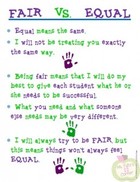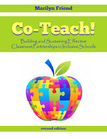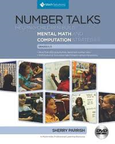
"That's not fair.”
We've all heard either our own or someone else's
child claim those very words when they are not getting what they want or receive the same amount of (food, attention, playing time) as someone else.
It is often misunderstood, especially by children, what
fair really means. To help the students understand the difference between fair and equal, we first demonstrated some scenarios, then brainstormed everyday examples and finally connected their understanding to classroom learning.
I started by taping a dollar bill on the top of the white board. I asked a tall student and a student on the shorter side to come up to the board and said whoever claims the bill first can keep it (not for keeps). Everyone laughed knowing Jack would quite easily reach the bill and remove it from the board before Charlie. Charlie was jumping up and down trying to come into reach with the dollar. Kids began shouting, “That’s not fair!" Jack is taller than Charlie; of course he is going to get it. He doesn’t have a
chance"
"How can we make it fair?" I asked.
"Charlie could use a step stool or chair."
“Okay, let's try again.” After they both reached the dollar simultaneously, we discussed that now that they were about the same height, it was in fact fair. Since Charlie was given what he needed he was not at a disadvantage. It was then pointed out that fair is not about what you WANT, but what you NEED. YES! And that is how we will treat each of them in the classroom, not necessarily equally, but always fairly. To be fair, we will give each of the students what they need to succeed in the classroom. Some students will get a "step stool", while others may not need it.
For our next demonstration a sentence was written on the board. Ms. Frenkel read it with ease while I struggled to decipher the words. I was not given the boost I needed, my glasses."That's no fair." True and we would never deprive a student what they need to succeed, ever. Kids caught on quite quickly and brainstormed other everyday situations where people are not always treated equally, but treated fairly.
Once the students could visualize various ways in which people are not treated equally, and also understand it was fair (in everyday situations). It was easier for them to see fairness in the classroom setting.
These are fair because it is what the student needs to learn, practice and succeed. When all students get what they need to learn in our classroom, then our classroom is in fact an environment where everyone is treated fairly. All things are not equal in our classroom, but they are fair!
We've all heard either our own or someone else's
child claim those very words when they are not getting what they want or receive the same amount of (food, attention, playing time) as someone else.
It is often misunderstood, especially by children, what
fair really means. To help the students understand the difference between fair and equal, we first demonstrated some scenarios, then brainstormed everyday examples and finally connected their understanding to classroom learning.
I started by taping a dollar bill on the top of the white board. I asked a tall student and a student on the shorter side to come up to the board and said whoever claims the bill first can keep it (not for keeps). Everyone laughed knowing Jack would quite easily reach the bill and remove it from the board before Charlie. Charlie was jumping up and down trying to come into reach with the dollar. Kids began shouting, “That’s not fair!" Jack is taller than Charlie; of course he is going to get it. He doesn’t have a
chance"
"How can we make it fair?" I asked.
"Charlie could use a step stool or chair."
“Okay, let's try again.” After they both reached the dollar simultaneously, we discussed that now that they were about the same height, it was in fact fair. Since Charlie was given what he needed he was not at a disadvantage. It was then pointed out that fair is not about what you WANT, but what you NEED. YES! And that is how we will treat each of them in the classroom, not necessarily equally, but always fairly. To be fair, we will give each of the students what they need to succeed in the classroom. Some students will get a "step stool", while others may not need it.
For our next demonstration a sentence was written on the board. Ms. Frenkel read it with ease while I struggled to decipher the words. I was not given the boost I needed, my glasses."That's no fair." True and we would never deprive a student what they need to succeed, ever. Kids caught on quite quickly and brainstormed other everyday situations where people are not always treated equally, but treated fairly.
- Babies, kids and adults will not be served the same amount of food because our calorie intake and nutritional needs are different.
- A child learning to ride a bike will use training wheels, while someone who already knows how to balance will not use training wheels.
- Someone who is afraid of the dark may use a night light, but not all people need night lights.
Once the students could visualize various ways in which people are not treated equally, and also understand it was fair (in everyday situations). It was easier for them to see fairness in the classroom setting.
- It is fair that some students use the computer and others use paper.
- It is fair if students meet with Ms. K or Ms. F., but others don't.
- It is fair if some students use "offices" to do their work and others don't.
- It is fair if some students work on a project while others work on skill sheets.
These are fair because it is what the student needs to learn, practice and succeed. When all students get what they need to learn in our classroom, then our classroom is in fact an environment where everyone is treated fairly. All things are not equal in our classroom, but they are fair!

It is important to teach fairness to any group of students, but in a class where 1/3 of the class have learning disabilities it is imperative to make it clear that we will be fair so all students get what they need to tackle their challenges and be successful in their learning, And there certainly will not always be an equal share of your teachers' time. (This is a great follow up lesson after Strengths and challenges)
Children of special needs are often afraid of appearing different than others, or being treated differently in the classroom. So from the very beginning we discuss how we are all different, and how we all have different needs. When students understand fairness in terms of getting what they need, they don't feel so different.
A co-teaching classroom is set up differently than most classrooms. Students have two teachers always observing and helping. Students need to know from the beginning that Ms. Frenkel and I are both their teachers, and just as we are going to treat them fairly they must also treat us fairly. What one teacher tells a student is what both teachers agree upon. There is no manipulation. Sometimes our time in the classroom or spent with students may not appear “fair” or “equal”, but it is fair because it is what we each need to be effective and supportive teachers.
Children of special needs are often afraid of appearing different than others, or being treated differently in the classroom. So from the very beginning we discuss how we are all different, and how we all have different needs. When students understand fairness in terms of getting what they need, they don't feel so different.
A co-teaching classroom is set up differently than most classrooms. Students have two teachers always observing and helping. Students need to know from the beginning that Ms. Frenkel and I are both their teachers, and just as we are going to treat them fairly they must also treat us fairly. What one teacher tells a student is what both teachers agree upon. There is no manipulation. Sometimes our time in the classroom or spent with students may not appear “fair” or “equal”, but it is fair because it is what we each need to be effective and supportive teachers.





 RSS Feed
RSS Feed